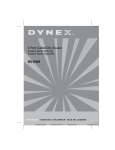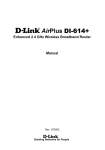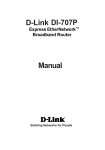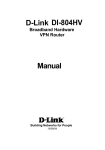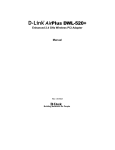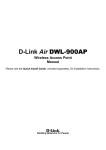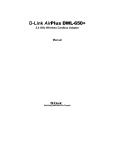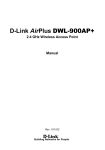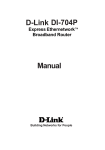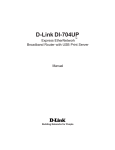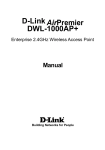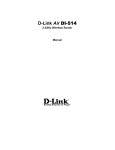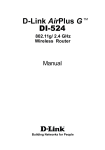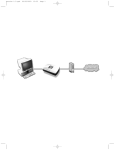Download D-Link DI-614+ Installation guide
Transcript
D-Link AirPlus DI-614+ Enhanced 2.4GHz Wireless Broadband Router Manual Building Networks for People Contents Package Contents ................................................................................ 3 Introduction ........................................................................................... 4 Wireless Basics .................................................................................... 6 Getting Started ..................................................................................... 9 Using the Configuration Menu ............................................................ 10 Troubleshooting .................................................................................. 50 Networking Basics .............................................................................. 55 Technical Specifications ..................................................................... 68 Contacting Technical Support ............................................................. 70 Warranty ............................................................................................. 71 Registration ........................................................................................ 74 2 Package Contents Contents of Package: D-Link AirPlus DI-614+ Enhanced 2.4GHz Wireless Broadband Router Power Adapter – 5V DC, 2.5A Manual on CD Quick Installation Guide Note: Using a power supply with a different voltage rating than the one included with the DI-614+ will cause damage and void the warranty for this product. If any of the above items are missing, please contact your reseller. System Requirements For Configuration: Computer with a Windows, Macintosh, or Linux based operating system with an installed Ethernet adapter Internet Explorer or Netscape Navigator, version 6.0 or above, with JavaScript enabled 3 Introduction The D-Link AirPlus DI-614+ Wireless Broadband Router is an enhanced 802.11b high-performance, wireless router. It is an ideal way to extend the reach and number of computers connected to your wireless network. Unlike most 802.11b routers, the DI-614+ is capable of data transfer speeds up to 22 Mbps* (compared to the standard 11 Mbps) when used with other D-Link AirPlus products such as the DWL-520+ Wireless PCI Adapter. After completing the steps outlined in the Quick Installation Guide (included in your package) you will have the ability to share information and resources, such as files and printers, and enjoy the freedom that wireless networking delivers. The DI-614+ is compatible with most popular operating systems, including Macintosh, Linux and Windows, and can be integrated into a large network. This Manual is designed to help you connect the Router and the D-Link AirPlus 2.4GHz Wireless Adapters into a network in Infrastructure mode. Please take a look at the Getting Started section in this manual to see an example of an Infrastructure network using the DI-614+. This manual provides a quick introduction to wireless technology and its application as it relates to networking. Please take a moment to read through this manual and get acquainted with wireless technology. *Maximum wireless signal rate derived from IEEE Standard 802.11b specifications. Actual data throughput wil vay. Network conditions and environmental factors, including volume of network traffic, building materials and construction, and network overhead lower actual data throughput rate. 4 Connections Auto-Sensing Ports:All ports (both LAN and WAN) auto-sense cable types to accomodate stright-through or cross-over cable. LAN ports provide connections to Ethernetenabled devices. WAN port is the connection for the Ethernet cable to the Cable or DSL modem Pressing the Reset Button restores the router to its original factory default settings. Receptor for the Power Adapter LEDs WAN LED: A solid light indicates connection on the WAN port. This LED blinks during transmission. Power LED: A solid light indicates a proper connection to the power supply. WLAN LED: A solid light indicates that the wireless segment is ready. This LED blinks during wireless transmission. M1 LED: A solid light indicates that the DI-614+ is ready. M2 LED: A solid light indicates that the unit is defective. Local Networ LED: A solid light indicates a connection to an Ethernet-enabled computer on ports 1-4. This LED blinks during data transmission. 5 Wireless Basics D-Link AirPlus wireless products are based on industry standards to provide easy-to-use and compatible high-speed wireless connectivity within your home, business or public access wireless networks. Strictly adhering to the IEEE standard, the D-Link AirPlus wireless family of products will allow you to access the data you want, when and where you want it. You will be able to enjoy the freedom that wireless networking delivers. A wireless local area network (WLAN) is a cellular computer network that transmits and receives data with radio signals instead of wires. Wireless LANs are used increasingly in both home and office environments, and public areas such as airports, coffee shops and universities. Innovative ways to utilize WLAN technology are helping people to work and communicate more efficiently. Increased mobility and the absence of cabling and other fixed infrastructure have proven to be beneficial for many users. Wireless users can use the same applications they use on a wired network. Wireless adapter cards used on laptop and desktop systems, support the same protocols as Ethernet adapter cards. Under many circumstances, it may be desirable for mobile network devices to link to a conventional Ethernet LAN in order to use servers, printers or an Internet connection supplied through the wired LAN. A Wireless Access Point (AP) is a device used to provide this link. People use wireless LAN technology for many different purposes: Mobility - Productivity increases when people have access to data in any location within the operating range of the WLAN. Management decisions based on real-time information can significantly improve worker efficiency. Low Implementation Costs – WLANs (Wireless Local Area Networks) are easy to set up, manage, change and relocate. Networks that frequently change, both physically and logically, can benefit from WLANs ease of implementation. WLANs can operate in locations where installation of wiring may be impractical. Installation Speed and Simplicity - Installing a wireless LAN system can be fast and easy and can eliminate the need to pull cable through walls and ceilings. Network Expansion - Wireless technology allows the network to go where wires cannot go. Reduced Cost-of-Ownership - While the initial investment required for wireless LAN hardware might be higher than the cost of wired LAN hardware, overall installation expenses and life-cycle costs will be significantly lower. Long-term cost benefits are greatest in dynamic environments requiring frequent moves, adds, and changes. Scalability – Wireless Local Area Networks (WLANs) can be configured in a variety of topologies to meet the needs of specific applications and installations. Configurations are easily changed and range from peer-to-peer networks suitable for a 6 Wireless Basics small number of users to full infrastructure networks of thousands of users that allow roaming over a broad area. D-Link AirPlus Wireless Family of LAN products include: Enhanced 2.4GHz Wireless Cardbus Adapters used with laptop computers (DWL-650+) Enhanced 2.4GHz Wireless PCI cards used with desktop computers (DWL-520+) Enhanced 2.4GHz Wireless Router and Access Point (DI-614+, DWL900AP+) The DI-614+ is also compatible with the D-Link Air 802.11b family of products, which include: 2.4GHz Wireless Cardbus Adapters used with laptop computers (DWL-650) 2.4GHz Wireless PCI cards used with desktop computers (DWL-520) Wireless Router/Access Point/Print Servers (DI-713P) Wireless Access Points (DWL-1000AP, DWL-900AP) Standards - Based Technology The IEEE standard-based technology assures that the D-Link AirPlus Products are interoperable with existing compatible 2.4GHz wireless technology. This means you will be able to transfer large files quickly or even watch a movie in MPEG format over your network without noticeable delays. The technology works by using multiple frequencies in the 2.4GHz range at speeds up to 22 Mbps. D-Link AirPlus products will automatically sense the best possible connection speed to ensure the greatest speed and range possible with the technology. Installation Considerations Designed to go up to 1,312 feet (400 meters) outdoors and up to 328 feet (100 meters) indoors, the D-Link AirPlus DI-614+ lets you access your network with your laptop computer from virtually anywhere. Keep in mind, however, that the number, thickness and location of walls, ceilings or other objects that the wireless signals must pass thru may limit range. Typical ranges vary depending on the types of materials and background RF (radio frequency) noise in your home or business. The key to maximizing range is to follow these basic guidelines: 7 Wireless Basics 1. Keep the number of walls and ceilings between the wireless Access Point and your receiving device (e.g., the DWL-650+) to a minimum - Each wall or ceiling can reduce your D-Link AirPlus Wireless product’s range from 3-90 feet (1-30 meters.) Position your Access Points, Residential Gateways, and computers so that the number of walls or ceilings is minimized. 2. Be aware of the direct line between Access Points, Residential Gateways (routers) and computers. A wall that is 1.5 feet thick (.5 meters), at a 45-degree angle appears to be almost 3 feet (1 meter) thick. At a 2-degree angle it looks over 42 feet (14 meters) thick! Try to make sure that the Access Points and adapters are positioned so that the signal will travel straight through a wall or ceiling for better reception. 3. Building Materials make a difference - A solid metal door or aluminum studs may have a negative effect on range. Try to position Access Points, and computers with wireless adapters so that the signal passes through drywall or open doorways and not other materials. 4. Make sure that the device’s antenna is positioned for best reception by using the software signal strength tools included with your product. 5. Keep your product away (at least 3-6 feet or 1-2 meters) from electrical devices or appliances that may generate extreme RF noise. For the average home, signal range should not be an issue. If you experience low or no signal strength in areas of your home that you wish to access, consider positioning the Access Point in a location directly between the computers with wireless adapters. Additional Access Points can be connected to provide better coverage in rooms where the signal does not appear as strong as desired. The Infrastructure Network example shown on the following page contains the following D-Link network devices: A wireless Broadband Router - D-Link AirPlus DI-614+ A laptop computer with a Wireless Adapter - D-Link AirPlus DWL-650+ A desktop computer with a Wireless Adapter - D-Link AirPlus DWL-520+ A Cable Modem - D-Link DCM-201 8 Getting Started With its default settings, the DI-614+, when activated, will connect with other DLink Air or AirPlus products, right out of the box. Networking Basics - learn how to check and assign your IP Address; share printers and files. Using the Configuration Menu - learn the settings for the DI-614+, using the web-based interface. 1 2 Please refer to the following sections of this manual for additional information about setting up a network: 3 4 5 For a typical network setup at home (as shown above), please do the following: You will need broadband Internet access (a Cable or DSL subscription line into your home or office). Consult with your Cable or DSL provider for proper installation of the modem. Connect the Cable or DSL modem to the DI-614+ wireless broadband router (see the Quick Installation Guide included with the DI-614+). If you are connecting a desktop computer to your network, you can install the D-Link DFE-530TX+ ethernet adapter into an available PCI slot. (See the Quick Installation Guide included with the DWL-530TX+.) If you are connecting a laptop computer to your network, install the drivers for the Ethernet Cardbus adapter (e.g., D-Link DWL-650+) into a laptop computer.(See the Quick Installation Guide included with the DWL-650+.) 9 Using the Configuration Menu Whenever you want to configure your network or the DI-614+, you can access the Configuration Menu by opening the web-browser and typing in the IP Address of the DI-614+. The DI-614+ default IP Address is shown below: Open the web browser Type in the IP Address of the DI-614+ http://192.168.0.1 Note: if you have changed the default IP Address assigned to the DI-614+, make sure to enter the correct IP Address. The factory default User name is admin and the default Password is blank (empty). It is recommended that you change the admin password for security purposes. Please refer to Tools>Admin to change the admin password. Home > Wizard The Home>Wizard screen will appear. Please refer to the Quick Installation Guide for more information regarding the Setup Wizard. Apply Cancel Help Clicking Apply will save changes made to the page. Clicking Cancel will clear changes made to the page. Clicking Help will bring up helpful information regarding the page. Clicking Restart will restart the router. (Necessary for some changes.) 10 Using the Configuration Menu Home > Wireless Wireless Settings are settings for the (Access Point) Portion of the Wireless Router. It allows you to change the wireless settings to fit an existing wireless network or to customize your wireless network. Enabled or Disabled By default, Wireless is Enabled. If you do not want to use the Wireless feature on the DI-614+, you can disable it by selecting Disabled. SSID Service Set Identifier (SSID) is the name designated for a specific wireless local area network (WLAN). The SSID’s factory default setting is “default”. The SSID can be easily changed to connect to an existing wireless network or to establish a new wireless network. Channel Indicates the channel setting for the DI-614+. By default the channel is set to 6. The Channel can be changed to fit the channel setting for an existing wireless network or to customize the wireless network. Auto Scan Click the check box to enable Auto Scan. Enabling this will allow the device to detect the best wireless channel to use. 11 Using the Configuration Menu Home > Wireless (Continued) WEP Wired Equivalent Protocol (WEP) is a wireless security protocol for Wireless Local Area Networks (WLAN). WEP provides security by encrypting the data that is sent over the WLAN. The DI-614+ supports 3 levels of WEP Encryption: 64Bit encryption, 128Bit encryption, and 256Bit encryption. WEP is disabled by default. The WEP setting can be changed to fit an existing wireless network or to customize your wireless network. Shared Key In this mode, in order to access the DI-614+ on the network, the device must be listed in the MAC Address Control List. Open System The DI-614+ will be visible to all devices on the network. This is the default setting. The Key Types that are supported by the DI-614+ are HEX (Hexadecimal) and ASCII (American Standard Code for Information Interchange.) The Key Type can be changed to fit an existing wireless network or to customize your wireless network. Key Type KEYS Keys 1-4 allow you to easily change wireless encryption settings to maintain a secure network. Simply select the specific key to be used for encrypting wireless data on the network. 12 Using the Configuration Menu Home > Wireless > WPA Wi-Fi Protected Access authorizes and authenticates users onto the wireless network. WPA uses stronger security than WEP and is based on a key that changes automatically at a regular interval. This mode requires a RADIUS server in the network. Radius Server 1 IP - Enter the IP Address of the RADIUS server. Port - Enter the port number that your RADIUS server uses for Authentication. The default setting of 1812 is the port setting for many RADIUS servers. Shared Secret - Enter the Shared Secret. The Shared Secret must be the same as the Shared Secret on your RADIUS server. Radius Server 2 Optional. If you have a second RADIUS server, you will input the same information as shown above. 13 Using the Configuration Menu Home > Wireless > WPA-PSK Wi-Fi Protected Access - Pre-Shared Key mode means that the wireless client and the router must have the same passphrase in order to establish the wireless connection. A RADIUS server is not required with PSK. Passphrase Enter a passphrase for the router. The RADIUS server should use the same passphrase (secret key) as the router. Confirmed PassphraseEnter the Passphrase again to confirm. 14 Using the Configuration Menu Home > WAN Choose WAN Type WAN stands for Wide Area Network. In this case WAN represents the mode in which you connect to the Internet. If you are uncertain, please ask your ISP which of the following represents your connection mode to the Internet: Dynamic IP Address Obtain an IP address from your ISP automatically (mainly for Cable users). Static IP Address Your ISP assigns you a Static IP Address. PPP over Ethernet Some ISPs require the use of PPPoE to connect to their services (mainly for DSL users). Others PPTP For use in Europe only. L2TP For specific ISP’s use only. Big Pond Cable For use in Australia only. 15 Using the Configuration Menu Home > WAN > Dynamic IP Address Most Cable modem users will select this option to obtain an IP Address automatically from their ISP (Internet Service Provider). Host Name This is optional, but may be required by some ISPs. The host name is the device name of the Router. MAC Address The default MAC Address is set to the WAN’s physical interface MAC address on the Router. Clone MAC Address This feature will copy the MAC address of the Ethernet card, and replace the WAN MAC address of the Router with this Ethernet card MAC address. It is not recommended that you change the default MAC address unless required by your ISP. Primary DNS Address Input the primary DNS address provided by your ISP Secondary DNS Address (Optional) Input the Secondary DNS address provided by your ISP. MTU Maximum Transmission Unit; default is 1500; you may need to change the MTU to conform to your ISP. 16 Using the Configuration Menu Home > WAN > Static IP Address Choose Static IP Address if all WAN IP information is provided to you by your ISP. You will need to enter in the IP address, subnet mask, gateway address, and DNS address(es) provided to you by your ISP. Each IP address entered in the fields must be in the appropriate IP form, which are four IP octets separated by a dot (x.x.x.x). The Router will not accept the IP address if it is not in this format. IP Address Input the IP Address provided by your ISP. Subnet Mask Input the Subnet Mask provided by your ISP. ISP Gateway Input the Gateway address provided by your ISP. MAC Address The default MAC Address is set to the WAN’s physical interface MAC address on the Router. Clone MAC Address This feature will copy the MAC address of the Ethernet card, and replace the WAN MAC address of the Router with this Ethernet card MAC address. It is not recommended that you change the default MAC address unless required by your ISP. Primary DNS Address Input the primary DNS address provided by your ISP. Secondary DNS Address (Optional) Input the Secondary DNS address provided by your ISP. MTU Maximum Transmission Unit; default is 1500; you may need to change the MTU to conform to your ISP. 17 Using the Configuration Menu Home > WAN > PPPoE Most DSL users will select this option to obtain an IP address automatically from their ISP through the use of PPPoE. Your PPPoE username provided by your ISP. User Name Password Your PPPoE password is provided by your ISP. Service Name (Optional) Check with your ISP for more information if they require the use of service name. IP Address (Optional) Enter in the IP Address if you are assigned a static PPPoE address. MAC Address The default MAC Address is set to the WAN’s physical interface MAC address on the Router. Clone MAC Address This feature will copy the MAC address of the Ethernet card, and replace the WAN MAC address of the Router with this Ethernet card MAC address. It is not recommended that you change the default MAC address unless required by your ISP. 18 Using the Configuration Menu Home > WAN > PPPoE (Continued) Primary DNS Address You will get the DNS IP automatically from your ISP but you may enter a specific DNS address that you want to use instead. Secondary DNS Address (Optional) Input the secondary DNS address. Maximum Idle Time Enter a maximum idle time during which Internet connection is maintained during inactivity. To disable this feature, enable Auto-reconnect. MTU Maximum Transmission Unit; default is 1492; you may need to change the MTU to conform to your ISP. Auto-reconnect If enabled, the Broadband Router will automatically connect to your ISP after your system is restarted or if the connection is dropped. 19 Using the Configuration Menu Home > WAN > PPTP Point-to-Point Tunneling Protocol (PPTP) is a WAN connection used in Europe. IP Address Enter the IP Address. Subnet Mask Enter the Subnet Mask. Server IP Enter the Server IP Address. PPTP Account Enter the PPTP account name. PPTP Password Enter the PPTP password. Maximum Idle Time Enter a maximum idle time during which Internet connection is maintained during inactivity. To disable this feature, enable Auto-reconnect. MTU Maximum Transmission Unit; default is 1400; you may need to change the MTU to conform to your ISP. Auto-reconnect If enabled, the Broadband Router will automatically connect to your ISP after your system is restarted or if the connection is dropped. 20 Using the Configuration Menu Home > WAN > L2TP Layer 2 Tunneling Protocol (L2TP) is a WAN connection. IP Address Enter the IP Address. Subnet Mask Enter the Subnet Mask. Server IP Enter the Server IP Address. L2TP Account Enter the PPTP account name. L2TP Password Enter the PPTP password. Maximum Idle Time Enter a maximum idle time during which Internet connection is maintained during inactivity. To disable this feature, enable Auto-reconnect. MTU Maximum Transmission Unit; default is 1400; you may need to change the MTU to conform to your ISP. Auto-reconnect If enabled, the Broadband Router will automatically connect to your ISP after your system is restarted or if the connection is dropped. 21 Using the Configuration Menu Home > WAN > BigPond Cable Dynamic IP Address for BigPond is a WAN connection used in Australia. User Name Enter in the username for the BigPond account. Password Enter the password for the BigPond account. Auth Server Select the auth server for the BigPond account. Login Server IP (Optional) Enter the Login Server name if required. MAC Address The default MAC Address is set to the WAN’s physical interface MAC address on the Router. Clone MAC Address This feature will copy the MAC address of the Ethernet card, and replace the WAN MAC address of the Router with this Ethernet card MAC address. It is not recommended that you change the default MAC address unless required by your ISP. 22 Using the Configuration Menu Home > LAN LAN is short for Local Area Network. This is considered your internal network. These are the IP settings of the LAN interface for the DI-614+. These settings may be referred to as Private settings. You may change the LAN IP address if needed. The LAN IP address is private to your internal network and cannot be seen on the Internet. IP Address The IP address of the LAN interface. The default IP address is: 192.168.0.1. Subnet Mask The subnet mask of the LAN interface. The default subnet mask is 255.255.255.0. Local Domain Name (Optional) The name of your local domain. DNS Relay You may choose to enable or disable DNS Relay. If disabled, the DNS address received on the WAN port will pass through to the LAN clients. 23 Using the Configuration Menu Home > DHCP DHCP stands for Dynamic Host Control Protocol. The DI-614+ has a built-in DHCP server. The DHCP Server will automatically assign an IP address to the computers on the LAN/private network. Be sure to set your computers to be DHCP clients by setting their TCP/IP settings to “Obtain an IP Address Automatically.” When you turn your computers on, they will automatically load the proper TCP/IP settings provided by the DI-614+. The DHCP Server will automatically allocate an unused IP address from the IP address pool to the requesting computer. You must specify the starting and ending address of the IP address pool. DHCP Server Enable or disable the DHCP service. Starting IP Address The starting IP address for the DHCP server’s IP assignment. Ending IP Address The ending IP address for the DHCP server’s IP assignment. Lease Time The length of time for the DHCP lease. Static DHCP Used to allow the DHCP server to assign the same IP adress to a specific MAC address. Enter the name, IP address, and MAC address into the fields. Select which DHCP client to clone. Name The name to be used to reference the specific static DHCP client. MAC Address The MAC address of the static DHCP client. DHCP Client Drop down list of all currently connected DHCP clients. DHCP Clients List Lists the DHCP clients connected to the DI-614+. Click Refresh to update the list. The table will show the Host Name, IP Address, and MAC Address of the DHCP client computer. 24 Using the Configuration Menu Advanced > Virtual Server The DI-614+ can be configured as a virtual server so that remote users accessing Web or FTP services via the public IP address can be automatically redirected to local servers in the LAN (Local Area Network). The DI-614+ firewall feature filters out unrecognized packets to protect your LAN network so all computers networked with the DI-614+ are invisible to the outside world. If you wish, you can make some of the LAN computers accessible from the Internet by enabling Virtual Server. Depending on the requested service, the DI-614+ redirects the external service request to the appropriate server within the LAN network. Enable Select to activate the policy. Name Private IP You can name the Virtual Server. The IP address of the internal computer that will be using the virtual service. Protocol Type Select the protocol the Virtual Server will use. Private/ Public Ports Enter in the private and public port or ports to be used. A range of ports can be specified with a hyphen. (e.g., 20-21) Schedule Select Always, or choose From and enter the time period during which the virtual service will be available. 25 Using the Configuration Menu Advanced > Applications Some applications require multiple connections, such as Internet gaming, video conferencing, and Internet telephony. These applications have difficulties working through NAT (Network Address Translation). Special Applications makes some of these applications work with the DI-614+. If you need to run applications that require multiple connections, specify the port normally associated with an application in the Trigger field, then enter the public ports associated with the trigger port into the Incoming Ports field. At the bottom of the screen, there are already defined special applications. To use them, select one from the drop down list and select an ID number you want to use. Then click the “Copy to” button and the router will fill in the appropriate information to the list. You will then need to enable the service. If the mechanism of Special Applications fails to make an application work, try using DMZ host instead. Note! Only one PC can use each Special Application tunnel. Enabled or Select to activate or deactivate the policy. Disabled Name You can name the defined special applications. Trigger Port This is the port used to trigger the application. It can be either a single port or a range of ports. Trigger Type Public Ports Select the trigger protocol you would like to initiate. To chage the selection, use the drop down arrow and other choices will be listed. This is the port number on the WAN side that will be used to access the application. You may define a single port or a range of ports. You can use a comma to add multiple ports or port ranges. Public Type Select the public type the special application will use. 26 Using the Configuration Menu Advanced > Filters > IP Filter Use IP (Internet Protocol) filters to allow or deny computers access to the Internet based on their IP address. Enabled or Disabled Click Enabled to apply the filter policy or click Disabled to enter an inactive filter policy. (You can reactivate the policy later.) IP Address Enter the IP address range of the computers that you want the policy to apply to. If it is only a single computer that you want the policy applied to, then enter the IP address of the computer in the Start Source IP and leave the End Source IP blank. Port Range Enter in the port range of the TCP/UDP ports that you want the policy to apply to. If it is only a single port that you want the policy applied to, then enter the port number in the Start Port field and leave the End Port field blank. If you want to use all the ports, you can leave the port range empty. Protocol Type Select the protocol type to allow or deny certain types of IP addresses. Schedule Select Always, or choose From and enter the time period during which the IP filter policy will be in effect. 27 Using the Configuration Menu Advanced > Filters > MAC Filters MAC (Media Access Control) Filters are used to deny or allow LAN (Local Area Network) computers from accessing the Internet and network by their MAC address. At the bottom of the screen, there is a list of MAC addresses from the DHCP client computers connected to the DI-614+. To use them, select one from the drop down list and select an IP number you want to use. Then click the “Copy to” button and the DI-614+ will fill in the appropriate information in the list. Disabled MAC Filter Select this option if you do not want to use MAC filters. Only allow computers with MAC address listed below to access the network Select this option to only allow computers that are in the list to access the network and Internet. All other computers will be denied access to the network and Internet. Only deny computers with MAC address listed below to access the network Select this option to only deny computers that are in the list to access the network and Internet. All other computers will be allowed access to the network and Internet. Name Enter a name to create a profile for the associated computer(s) on the network. MAC Address Enter the MAC Address of the client that will be filtered. DHCP Client Select from the DHCP Client list and click the Clone button to automatically clone that computer’s MAC address to the MAC address field. 28 Using the Configuration Menu Advanced > Parental Control >URL Blocking Use URL Blocking to deny LAN computers from accessing specific web sites by its URL. A URL is a specially formatted text string that defines a location on the Internet. If any part of the URL contains the blocked word, the site will not be accessible and the web page will not display. Disabled URL Blocking Select this option if you do not want to use URL Blocking. 29 Using the Configuration Menu Advanced > Parental Control > Domain Blocking Use Domain filters to allow or deny computers access to specific Internet domains whether it is through www, ftp, SNMP, etc. Domain filters apply to both wired computers connected to one of the four Ethernet LAN ports and to wireless clients connected wirelessly to the DI-614+. Disabled Domain Filter Select this option if you do not want to use Domain filters. Allow users to access the following domains and block all other domains Select this option to allow users to access the specified Internet domains listed below. Users will be denied access to all other Internet domains. Deny users to access the following domains and permit all other domains Select this option to deny users access to the specified Internet domains listed below. Users will be allowed access to all other Internet domains. Permitted/Blocked Domains This is a list of domain suffixes of the Internet domain you want to permit or block. (Example: shopping.com, sports.net.) 30 Using the Configuration Menu Advanced > Firewall Firewall Rules is an advance feature used to deny or allow traffic from passing through the device. It works in the same way as IP Filters with additional settings. You can create more detailed rules for the device. Enabled or Disabled Click Enabled to apply the filter policy or click Disabled to enter an inactive filter policy (You can reactivate the policy later). Name Enter the name of the Firewall Rule. Action Select Allow or Deny to allow or deny traffic to pass through the DI-614+. Interface Source Choose between a LAN or WAN source. An asterisk signifies the selection of both sources. Interface Destination Choose between a LAN or WAN destination. An asterisk signifies the selection of both destinations. IP Start The starting IP address for the filter policy. Leaving the field blank selects all IPs. IP End The ending IP address for the filter policy. Leaving the field blank sleects all IPs. 31 Using the Configuration Menu Advanced > Firewall (Continued) Protocol Select one of the following protocols: TCP, UDP, or ICMP. Port Range Enter in the port range of the TCP/UDP ports that you want the policy to apply to. If it is only a single port that you want the policy applied to, then enter the port number in the Start Port field and leave the End Port field blank. If you want to use all the ports, you can leave the port range empty. Schedule Select Always, or choose From and enter the time period during which the virtual service will be available 32 Using the Configuration Menu Advanced > DMZ If you have a computer that cannot run Internet applications properly from behind the DI-614+, then you can allow that computer to have unrestricted Internet access. Enter the IP address of that computer as a DMZ (Demilitarized Zone) host with unrestricted Internet access. Adding a client to the DMZ may expose that computer to a variety of security risks, so only use this option as a last resort. 33 Using the Configuration Menu Advanced > Performance Beacon Interval Beacons are packets sent by an Access Point to synchronize a wireless network. Specify a value. 100 is the default setting and is recommended. DTIM interval (Delivery Traffic Indication Message) 3 is the default setting. A DTIM is a countdown informing clients of the next window for listening to broadcast and multicast messages. Basic Rates Select the data rate. Default is 1-2-5.5-11-22Mbps. TX Rates Select the data rate. Default is 1-2-5.5-11-22Mbps. Preamble Type Long preamble is the default setting. (High traffic networks should use the shorter preamble type.) The preamble defines the length of the CRC block used in communication between the Access Point and the roaming wireless Network adapters.(Cyclic Redundancy Check is a common technique for detecting data transmission errors) 34 Using the Configuration Menu Advanced > Performance (Continued) SSID Broadcast Enabled is the default setting. Choose Enabled to broadcast the SSID across the network. All devices on a network must share the same SSID (Service Set Identifier) to establish communication. Choose Disabled if you do not wish to broadcast the SSID over the network. Antenna transmit power The DI-614+ has the option to adjust its wireless transmit power. Limiting transmit power can help in situations where you do not want the same signals overlapping one another. Antenna Selection Select Internal Antenna, External Antenna, or Diversity Antenna. Internal In this mode, the DI-614+ only uses the internal antenna for short distance coverage. External In this mode, the DI-614+ only uses the external antenna and extends wireless coverage. In this mode, the DI-614+ uses both the internal and external antenna and then uses the antenna that picks up the strongest signal. Diversity 4X Mode 4x Mode allows for higher speed wireless performance. Only other devices that support 4x Mode will be able to take advantage of the higher performance. 35 Using the Configuration Menu Tools> Admin There are two accounts that can access the Broadband Router’s Web-Management interface. They are admin and user. Admin has read/write access while user has readonly access. User can only view the settings but cannot make any changes. It is recommended that you change the admin password from the default setting. The default password is blank (no password). Password To change the admin and user passwords, enter in the old password, and enter the new password twice to confirm. Remote Management Remote Management allows the device to be configured through the WAN (Wide Area Network) port from the Internet using a web browser. A username and password is still required to access the browser-based management interface. IP Address Internet IP Address of the computer that has access to the DI-614+. If the IP Address is set to 0.0.0.0, this allows all Internet IP addresses to access the DI-614+. Port The port number used to access the DI-614+. E.g., http://x.x.x.x:80, where x.x.x.x. is the WAN IP address of the DI-614+ and 80 is the port used for the Web Management interface. 36 Using the Configuration Menu Tools> Time Set the time here by entering it manually or by using NTP (Network Time Protocol.) NTP is a standard protocol on the Internet that sychronizes the time settings accurately for all the computers on your network. Time Zone Select your time zone from the pull-down menu. Daylight Saving Select to enable or disable Daylight Saving. If you choose to enable this, enter the start and end date and the system time will automatically adjust on those dates Default NTP Server (Optional.) If you are enabling NTP to synchronize the time settings on your network using an NTP server, please enter the link to the default server. Set Device Date and Time If you are entering the time manually, select the correct Year, Month, Day, Hour, Minute, and Second. 37 Using the Configuration Menu Tools > System The current system settings can be saved as a file onto the local hard drive. The saved file or any other saved setting file created by the DI-614+ can be uploaded to the unit. To reload a system settings file, click on Browse to search the local hard drive for the file to be used. The device can also be reset back to factory default settings by clicking on the Reset to Default button. Use the restore feature only if necessary. This will erase previously saved settings for the unit. Make sure to save your system settings to the hard drive before doing a factory restore. Save Settings to Local Hard Drive Click Backup Setting to save the current settings to the local Hard Drive. Load Settings from Local Hard Drive Click Browse to find the settings file, then click Load. Restore to Factory Default Settings Click Reset to Default to restore the factory default settings. 38 Using the Configuration Menu Tools > Firmware You can upgrade the firmware by using this tool. First, check the D-Link support site for firmware updates at http://support.dlink.com. Make sure that the firmware you want to use is saved on the local hard drive of your computer. Click on Browse to search the local hard drive for the firmware that you downloaded from the D-Link website to be used for the update. Upgrading the firmware will not change any of your system settings but it is recommended that you save your system settings before doing a firmware upgrade. Browse After you have downloaded the new firmware, click Browse in this window to locate the firmware update on your hard drive. Click Apply to complete the firmware upgrade. Note: Do not power off the unit when it is being upgraded. When the upgrade is complete, the unit will automatically restart. 39 Using the Configuration Menu Tools >DDNS DDNS (Dynamic Domain Name System) keeps dynamic IP addresses (e.g., IP addresses assigned by a DHCP capable router or server) linked to a domain name. Users who have a Dynamic DNS account may use this feature on the DI-614+. DDNS When an IP address is automatically assigned by a DHCP server, DDNS automatically updates the DNS server. Select Disabled or Enabled. Server Address Select from the pull-down menu. Host Name Enter the Host name. Username Enter the username. Password Enter the password. 40 Using the Configuration Menu Tools > Misc 41 Using the Configuration Menu Tools > Misc (Continued) Ping Test This useful diagnostic utility can be used to check if a computer is on the Internet. It sends ping packets and listens for replies from the specific host. Restart Device Click reboot to restart the unit. Block WAN Ping Click Enable to block the WAN ping. Computers on the Internet will not get a reply back from the DI-614+ when it is being “ping”ed. This may help to increase security. UPnP Setting Universal Plug and Play is a feature that is preset to allow certain popular applications such as MSN messenger to be functional using the router without making any configurations. By default UPnP setting is set to enable. It is recommended to keep UPnP Setting on enable. Gaming Mode Click Enable to enable Gaming Mode. This feature allows many online games to work with the DI-614+. VPN Pass Through For users who telecommute or use Virtual Private Network (VPN), you can select PPTP or IPSec to be used with this router. WAN select to 10/100 Mbps This option allows the user to select 10Mbps, 100 Mbps, or 10/100Mbps Auto for the WAN port. You may need to change the WAN port speed if you are experiencing connection problems with your Cable or DSL modem. 42 Using the Configuration Menu Tools > Cable Test Diagnostic Cable Tester is an advanced feature that integrates a LAN cable tester on every Ethernet port on the router. Through the graphical user interface (GUI), Cable Tester can be used to remotely diagnose and report cable faults such as opens, shorts, swaps, and impedance mismatch. The Cable Tester feature significantly reduces service calls and returns by allowing users to easily troubleshoot their cable connections. Ports The Ethernet port names associated to the physical ports. Link Status The current link status of the Ethernet cable connected to the respective Ethernet port. More Info Click on More Info for detailed information about the cable link status. The following window will appear. Refresh Click on Refresh to run the cable test. Allow the router a few seconds to complete the test. 43 Using the Configuration Menu Status > Device Info This screen displays information about the DI-614+. DHCP Release Click to release IP addresses sent from the DHCP server. DHCP Renew Click to renew IP addreses sent from the DHCP server. 44 Using the Configuration Menu Status > Log This screen displays activities occurring on the DI-614+. First Page- Click First Page to go to the first page of the log. Last Page- Click Last Page to go to the last page of the log. Previous- Click Previous to go to the previous page of the log. Next- Click Next to go to the next page of the log. Clear- Click Clear to clear the log. Log Settings- Click for advanced features (see next page.) 45 Using the Configuration Menu Status > Log > Log Settings E-Mail Alert The DI-614+ can be set up to send the log files to a specific email address. SMTP Server IP Enter in the IP address of the mail server. Email Address Enter in the email address of the recipient who will receive the email log. Send Mail Now Click to send mail immediately. Save Log File to Local Hard Drive Selecting this allows you to save the log to a local hard drive. A window will appear prompting you to save the file to a specific location. Log Type Select the types of activity to log. 46 Using the Configuration Menu Status > Stats In Stats section, traffic statistics are displayed. Refresh This will update the page. Reset This will reset the packet counter to zero. WAN Displays Received / Transmitted packets from the WAN port. LAN Displays Received / Transmitted packets from the LAN port. WIRELESS Displays received and transmitted packets from the wireless network. 47 Using the Configuration Menu Status > Wireless The wireless client table displays a list of current connected wireless clients. This table also displays the time and MAC address of the wireless client connected. 48 Using the Configuration Menu Help This screen displays the complete Help menu. For help at anytime, click the Help tab in the Configuration menu. 49 Troubleshooting This chapter provides solutions to problems that can occur during the installation and operation of the DI-614+ Wireless Access Point. We cover various aspects of the network setup, including the network adapters. Please read the following if you are having problems. (Note: It is recommended that you use an Ethernet connection to configure the DI-614+ Access Point.) 1. The computer used to configure the DI-614+ cannot access the Configuration menu. Check that the Ethernet LED on the DI-614+ is ON. If the LED is not ON, check that the cable for the Ethernet connection is securely inserted. Check that the Ethernet Adapter is working properly. Please see item 6 (Check that the drivers for the network adapters are installed properly) in this Troubleshooting section to check that the drivers are loaded properly. Check that the IP Address is in the same range and subnet as the DI-614+. Please see Checking the IP Address in Windows XP in the Networking Basics section of this manual. Note: The IP Address of the DI-614+ is 192.168.0.1. All the computers on the network must have a unique IP Address in the same range, e.g., 192.168.0.x. and a Subnet Mask of 255.255.255.0. Any computers that have identical IP Addresses will not be visible on the network. Do a Ping test to make sure that the DI-614+ is responding. Go to Start>Run>Type Command>Type ping 192.168.0.1. A successful ping will show four replies. 50 Troubleshooting 2. The wireless client cannot access the Internet in the Infrastructure mode. Make sure the wireless client is associated and joined with the correct router. To check this connection: Right-click on the Local Area Connection icon in the taskbar> select View Available Wireless Networks. The Connect to Wireless Network screen will appear. Please make sure you have selected the correct available network, as shown in the illustrations below. Default Check that the IP Address assigned to the wireless adapter is within the same IP Address range as the gateway. (Since the DI-614+ has an IP Address of 192.168.0.1, wireless adapters must have an IP Address in the same range, e.g., 192.168.0.x. Each device must have a unique IP Address; no two devices may have the same IP Address. The subnet mask must be the same for all the computers on the network.) To check the IP Address assigned to the wireless adapter, double-click on the Local Area Connection icon in the taskbar > select the Support tab and the IP Address will be displayed. (Please refer to Checking the IP Address in the Networking Basics section of this manual.) If it is necessary to assign a Static IP Address to the wireless adapter, please refer to the appropriate section in Networking Basics. If you are entering a DNS Server address you must also enter the Default Gateway Address. (Remember that if you have a DHCP-capable router, you will not need to assign a Static IP Address. See Networking Basics: Assigning a Static IP Address.) 51 Troubleshooting 3. Check that the drivers for the network adapters are installed properly. You may be using different network adapters than those illustrated here, but this procedure will remain the same, regardless of the type of network adapters you are using. Go to Start. Click Properties. Right-click on My Computer. NOTE: Screen shots taken using Windows XP. If you are using a different Operating System your screen may look different. Select the Hardware Tab. Click Device Manager. 52 Troubleshooting Double-click on Network Adapters. Right-click on D-Link AirPlus DWL-650+ Wireless Cardbus Adapter. Select Properties to check that the drivers are installed properly. D-Link AirPlus DWL-650+ Wireless Cardbus Look under Device Status to check that the device is working properly. Click OK. 53 Troubleshooting 4. Resetting the DI-614+ to Factory Default Settings After you have tried other methods for troubleshooting your network, you may choose to Reset the DI-614+ to the factory default settings. Remember that D-Link AirPlus products network together, out of the box, at the factory default settings. To hard-reset the D-Link AirPlus DI-614+ to Factory Default Settings, please do the following: Locate the Reset button on the back of the DI-614+. Use a paper clip to press the Reset button. Hold for about 10 seconds and then release. After the DI-614+ reboots (this may take a few minutes) it will be reset to the factory Default settings. 54 Networking Basics Using the Network Setup Wizard in Windows XP In this section you will learn how to establish a network at home or work, using Microsoft Windows XP. Note: Please refer to websites such as http://www.homenethelp.com and http://www.microsoft.com/windows2000 for information about networking computers using Windows 2000, Me or 98. Go to Start>Control Panel>Network Connections Select Set up a home or small office network When this screen appears, Click Next. 55 Networking Basics Please follow all the instructions in this window: Click Next. In the following window, select the description that best fits your computer. If your computer connects to the internet through a gateway/router, select the second option as shown. Click Next. 56 Networking Basics Enter a Computer description and a Computer name (optional). Click Next. Enter a Workgroup name. All computers on your network should have the same Workgroup name. Click Next. 57 Networking Basics Please wait while the Network Setup Wizard applies the changes. When the changes are complete, click Next. Please wait while the Network Setup Wizard configures the computer. This may take a few minutes. 58 Networking Basics In the window below, select the option that fits your needs. In this example, Create a Network Setup Disk has been selected. You will run this disk on each of the computers on your network. Click Next. Insert a disk into the Floppy Disk Drive, in this case drive A. 59 Networking Basics Please read the information under Here’s how in the screen below. After you complete the Network Setup Wizard you will use the Network Setup Disk to run the Network Setup Wizard once on each of the computers on your network. To continue click Next. 60 Networking Basics Please read the information on this screen, then click Finish to complete the Network Setup Wizard. The new settings will take effect when you restart the computer. Click Yes to restart the computer. You have completed configuring this computer. Next, you will need to run the Network Setup Disk on all the other computers on your network. After running the Network Setup Disk on all your computers, your new wireless network will be ready to use. 61 Networking Basics Naming your Computer To name your computer, please follow these directions. In Windows XP: Click Start (in the lower left corner of the screen). Right-click on My Computer. Select Properties and click. Select the Computer Name Tab in the System Properties window. You may enter a Computer Description if you wish; this field is optional. To rename the computer and join a domain, Click Change. 62 Networking Basics Naming your Computer In this window, enter the Computer name. Select Workgroup and enter the name of the Workgroup. All computers on your network must have the same Workgroup name. Click OK. OK Assigning a Static IP Address in Windows XP/2000 Note: Residential Gateways/Broadband Routers will automatically assign IP Addresses to the computers on the network, using DHCP (Dynamic Host Configuration Protocol) technology. If you are using a DHCP-capable Gateway/Router you will not need to assign Static IP Addresses. If you are not using a DHCP capable Gateway/Router, or you need to assign a Static IP Address, please follow these instructions: Go to Start. Double-click on Control Panel. 63 Networking Basics Assigning a Static IP Address in Windows XP/2000 Double-click on Network Connections. Right-click on Local Area Connections. Double-click on Properties. 64 Networking Basics Assigning a Static IP Address in Windows XP/2000 Click on Internet Protocol (TCP/IP). Click Properties. Enter the LAN IP address of the Wireless Router. (D-Link wireless routers have a LAN IP address of 192.168.0.1.) The DNS server information will be supplied by your ISP (Internet Service Provider). Click OK 192 168 0 1 192 168 0 1 65 Networking Basics Assigning a Static IP Address with Macintosh OSX Go to the Apple Menu and select System Preferences. cClick on Network. Select Built-in Ethernet in the Show pull-down menu. Select Manually in the Configure pull-down menu. Input the Static IP Address, the Subnet Mask, and the Router IP Address in the appropriate fields. Click Apply Now. 66 Networking Basics Selecting a Dynamic IP Address with Macintosh OSX Go to the Apple Menu and select System Preferences. Click on Network. Select Built-in Ethernet in the Show pull-down menu. Select Using DHCP in the Configure pull-down menu. Click Apply Now. The IP Address, Subnet mask, and the Router’s IP Address will appear in a few seconds. 67 Technical Specifications Standards IEEE 802.3 10BASE-T Ethernet IEEE 802.3u 100BASE-TX Fast Ethernet IEEE 802.11b VPN Pass Through Function PPTP IPSec Advanced Firewall Features Device Management Web-Based – Internet Explorer 6.0 or later; Netscape Navigator 6 or later; or other Java- enabled browsers. Wireless Data Rates* With Automatic Fallback 22Mbps 11Mbps 5.5Mbps 2Mbps 1Mbps Encryption 64/128/256-bit RC4 Media Access Control CMSA/CA with ACK Wireless Frequency Range 2.4GHz to 2.46GHz Wireless Operating Range Indoors: Up to 328 feet (100 meters) Outdoors: Up to 1,312 feet (400 meters) Wireless Modulation Technology PBCC - Packet Binary Convolutional Coding DSSS - Direct Sequence Spread Spectrum 11-chip Barker sequence * Maximum wireless signal rate derived from IEEE Standard 802.11b specifications. Actual data throughput will vary. Network conditions and environmental factors, including volume of traffic, building materials and construction, and network overhead lower actual data throughput rate. 68 Technical Specifications Modulation Technique Barker (1Mbps/0db) Barker (2Mbps/3db) CCK (5.5Mbps/5.5db) PBCC (5.5Mbps/1.4db) CCK (11Mbps/8.6db) PBCC (11Mbps/4.5db) PBCC (22Mbps/8.5db) Wireless Transmit Power 15dBm ± 2dB External Antenna Type Single detachable reverse SMA LEDs Power M1 M2 WAN Local Network - 10/100 WLAN (Wireless Connection) Operating Temperature 32°F to 131°F ( 0°C to 55°C) Humidity 95% maximum (non-condensing) Power DC 5V 2.5A Safety & Emissions FCC UL Dimensions L = 7.56 inches (192mm) W = 4.65 inches (118mm) H = 1.22 inches (31mm) Weight ~10.8 oz. (0.3kg) 69 Technical Support You can find software updates and user documentation on the D-Link website. D-Link provides free technical support for customers within the United States and within Canada for the duration of the warranty period on this product. U.S. and Canadian customers can contact D-Link technical support through our website, or by phone. Tech Support for customers within the United States: D-Link Technical Support over the Telephone: (877) 453-5465 24 hours a day, seven days a week. D-Link Technical Support over the Internet: http://support.dlink.com email:[email protected] Tech Support for customers within Canada: D-Link Technical Support over the Telephone: (800) 361-5265 Monday to Friday 7:30am to 12:00am EST D-Link Technical Support over the Internet: http://support.dlink.ca email:[email protected] 70 Warranty Subject to the terms and conditions set forth herein, D-Link Systems, Inc. (“D-Link”) provides this Limited warranty for its product only to the person or entity that originally purchased the product from: D-Link or its authorized reseller or distributor and Products purchased and delivered within the fifty states of the United States, the District of Columbia, U.S. Possessions or Protectorates, U.S. Military Installations, addresses with an APO or FPO. Limited Warranty: D-Link warrants that the hardware portion of the D-Link products described below will be free from material defects in workmanship and materials from the date of original retail purchase of the product, for the period set forth below applicable to the product type (“Warranty Period”), except as otherwise stated herein. 3-Year Limited Warranty for the Product(s) is defined as follows: Hardware (excluding power supplies and fans) Three (3) Years Power Supplies and Fans One (1) Year Spare parts and spare kits Ninety (90) days D-Link’s sole obligation shall be to repair or replace the defective Hardware during the Warranty Period at no charge to the original owner or to refund at D-Link’s sole discretion. Such repair or replacement will be rendered by D-Link at an Authorized D-Link Service Office. The replacement Hardware need not be new or have an identical make, model or part. D-Link may in its sole discretion replace the defective Hardware (or any part thereof) with any reconditioned product that D-Link reasonably determines is substantially equivalent (or superior) in all material respects to the defective Hardware. Repaired or replacement Hardware will be warranted for the remainder of the original Warranty Period from the date of original retail purchase. If a material defect is incapable of correction, or if D-Link determines in its sole discretion that it is not practical to repair or replace the defective Hardware, the price paid by the original purchaser for the defective Hardware will be refunded by D-Link upon return to D-Link of the defective Hardware. All Hardware (or part thereof) that is replaced by D-Link, or for which the purchase price is refunded, shall become the property of D-Link upon replacement or refund. Limited Software Warranty: D-Link warrants that the software portion of the product (“Software”) will substantially conform to D-Link’s then current functional specifications for the Software, as set forth in the applicable documentation, from the date of original retail purchase of the Software for a period of ninety (90) days (“Warranty Period”), provided that the Software is properly installed on approved hardware and operated as contemplated in its documentation. D-Link further warrants that, during the Warranty Period, the magnetic media on which D-Link delivers the Software will be free of physical defects. D-Link’s sole obligation shall be to replace the non-conforming Software (or defective media) with software that substantially conforms to D-Link’s functional specifications for the Software or to refund at D-Link’s sole discretion. Except as otherwise agreed by D-Link in writing, the replacement Software is provided only to the original licensee, and is subject to the terms and conditions of the license granted by D-Link for the Software. Software will be warranted for the remainder of the original Warranty Period from the date or original retail purchase. If a material non-conformance is incapable of correction, or if D-Link determines in its sole discretion that it is not practical to replace the non-conforming Software, the price paid by the original licensee for the nonconforming Software will be refunded by D-Link; provided that the non-conforming Software (and all copies thereof) is first returned to D-Link. The license granted respecting any Software for which a refund is given automatically terminates. Non-Applicability of Warranty: The Limited Warranty provided hereunder for hardware and software of DLink’s products will not be applied to and does not cover any refurbished product and any product purchased through the inventory clearance or liquidation sale or other sales in which D-Link, the sellers, or the liquidators expressly disclaim their warranty obligation pertaining to the product and in that case, the product is being sold “As-Is” without any warranty whatsoever including, without limitation, the Limited Warranty as described herein, notwithstanding anything stated herein to the contrary. Submitting A Claim: The customer shall return the product to the original purchase point based on its return policy. In case the return policy period has expired and the product is within warranty, the customer shall submit a claim to D-Link as outlined below: The customer must submit with the product as part of the claim a written description of the Hardware defect or Software nonconformance in sufficient detail to allow D-Link to confirm the same. 71 The original product owner must obtain a Return Material Authorization (“RMA”) number from the Authorized D-Link Service Office and, if requested, provide written proof of purchase of the product (such as a copy of the dated purchase invoice for the product) before the warranty service is provided. After an RMA number is issued, the defective product must be packaged securely in the original or other suitable shipping package to ensure that it will not be damaged in transit, and the RMA number must be prominently marked on the outside of the package. Do not include any manuals or accessories in the shipping package. D-Link will only replace the defective portion of the Product and will not ship back any accessories. The customer is responsible for all in-bound shipping charges to D-Link. No Cash on Delivery (“COD”) is allowed. Products sent COD will either be rejected by D-Link or become the property of D-Link. Products shall be fully insured by the customer and shipped to D-Link Systems, Inc., 17595 Mt. Herrmann, Fountain Valley, CA 92708. D-Link will not be held responsible for any packages that are lost in transit to D-Link. The repaired or replaced packages will be shipped to the customer via UPS Ground or any common carrier selected by D-Link, with shipping charges prepaid. Expedited shipping is available if shipping charges are prepaid by the customer and upon request. D-Link may reject or return any product that is not packaged and shipped in strict compliance with the foregoing requirements, or for which an RMA number is not visible from the outside of the package. The product owner agrees to pay D-Link’s reasonable handling and return shipping charges for any product that is not packaged and shipped in accordance with the foregoing requirements, or that is determined by D-Link not to be defective or non-conforming. What Is Not Covered: This limited warranty provided by D-Link does not cover: Products, if in D-Link’s judgment, have been subjected to abuse, accident, alteration, modification, tampering, negligence, misuse, faulty installation, lack of reasonable care, repair or service in any way that is not contemplated in the documentation for the product, or if the model or serial number has been altered, tampered with, defaced or removed; Initial installation, installation and removal of the product for repair, and shipping costs; Operational adjustments covered in the operating manual for the product, and normal maintenance; Damage that occurs in shipment, due to act of God, failures due to power surge, and cosmetic damage; Any hardware, software, firmware or other products or services provided by anyone other than D-Link; Products that have been purchased from inventory clearance or liquidation sales or other sales in which D-Link, the sellers, or the liquidators expressly disclaim their warranty obligation pertaining to the product. Repair by anyone other than D-Link or an Authorized D-Link Service Office will void this Warranty. Disclaimer of Other Warranties: EXCEPT FOR THE LIMITED WARRANTY SPECIFIED HEREIN, THE PRODUCT IS PROVIDED “AS-IS” WITHOUT ANY WARRANTY OF ANY KIND WHATSOEVER INCLUDING, WITHOUT LIMITATION, ANY WARRANTY OF MERCHANTABILITY, FITNESS FOR A PARTICULAR PURPOSE AND NON-INFRINGEMENT. IF ANY IMPLIED WARRANTY CANNOT BE DISCLAIMED IN ANY TERRITORY WHERE A PRODUCT IS SOLD, THE DURATION OF SUCH IMPLIED WARRANTY SHALL BE LIMITED TO NINETY (90) DAYS. EXCEPT AS EXPRESSLY COVERED UNDER THE LIMITED WARRANTY PROVIDED HEREIN, THE ENTIRE RISK AS TO THE QUALITY, SELECTION AND PERFORMANCE OF THE PRODUCT IS WITH THE PURCHASER OF THE PRODUCT. Limitation of Liability: TO THE MAXIMUM EXTENT PERMITTED BY LAW, D-LINK IS NOT LIABLE UNDER ANY CONTRACT, NEGLIGENCE, STRICT LIABILITY OR OTHER LEGAL OR EQUITABLE THEORY FOR ANY LOSS OF USE OF THE PRODUCT, INCONVENIENCE OR DAMAGES OF ANY CHARACTER, WHETHER DIRECT, SPECIAL, INCIDENTAL OR CONSEQUENTIAL (INCLUDING, BUT NOT LIMITED TO, DAMAGES FOR LOSS OF GOODWILL, LOSS OF REVENUE OR PROFIT, WORK STOPPAGE, COMPUTER FAILURE OR MALFUNCTION, FAILURE OF OTHER EQUIPMENT OR COMPUTER PROGRAMS TO WHICH D-LINK’S PRODUCT IS CONNECTED WITH, LOSS OF INFORMATION OR DATA CONTAINED IN, STORED ON, OR INTEGRATED WITH ANY PRODUCT RETURNED TO D-LINK FOR WARRANTY SERVICE) RESULTING FROM THE USE OF THE PRODUCT, RELATING TO WARRANTY SERVICE, OR ARISING OUT OF ANY BREACH OF THIS LIMITED WARRANTY, EVEN IF D-LINK HAS BEEN ADVISED OF THE POSSIBILITY OF SUCH DAMAGES. THE SOLE REMEDY FOR A BREACH OF THE FOREGOING LIMITED WARRANTY IS REPAIR, REPLACEMENT OR REFUND OF THE DEFECTIVE OR NON-CONFORMING PRODUCT. THE MAXIMUM LIABILITY OF D-LINK UNDER THIS WARRANTY IS LIMITED TO THE PURCHASE PRICE OF THE PRODUCT COVERED BY THE WARRANTY. THE FOREGOING EXPRESS WRITTEN WARRANTIES AND REMEDIES ARE EXCLUSIVE AND ARE IN LIEU OF ANY OTHER WARRANTIES OR REMEDIES, EXPRESS, IMPLIED OR STATUTORY 72 Governing Law: This Limited Warranty shall be governed by the laws of the State of California. Some states do not allow exclusion or limitation of incidental or consequential damages, or limitations on how long an implied warranty lasts, so the foregoing limitations and exclusions may not apply. This limited warranty provides specific legal rights and the product owner may also have other rights which vary from state to state. Trademarks: D-Link is a registered trademark of D-Link Systems, Inc. Other trademarks or registered trademarks are the property of their respective manufacturers or owners. Copyright Statement: No part of this publication or documentation accompanying this Product may be reproduced in any form or by any means or used to make any derivative such as translation, transformation, or adaptation without permission from D-Link Corporation/D-Link Systems, Inc., as stipulated by the United States Copyright Act of 1976. Contents are subject to change without prior notice. Copyright© 2002 by D-Link Corporation/D-Link Systems, Inc. All rights reserved. CE Mark Warning: This is a Class B product. In a domestic environment, this product may cause radio interference, in which case the user may be required to take adequate measures. FCC Statement: This equipment has been tested and found to comply with the limits for a Class B digital device, pursuant to part 15 of the FCC Rules. These limits are designed to provide reasonable protection against harmful interference in a residential installation. This equipment generates, uses, and can radiate radio frequency energy and, if not installed and used in accordance with the instructions, may cause harmful interference to radio communication. However, there is no guarantee that interference will not occur in a particular installation. If this equipment does cause harmful interference to radio or television reception, which can be determined by turning the equipment off and on, the user is encouraged to try to correct the interference by one or more of the following measures: Reorient or relocate the receiving antenna. Increase the separation between the equipment and receiver. Connect the equipment into an outlet on a circuit different from that to which the receiver is connected. Consult the dealer or an experienced radio/TV technician for help. FCC Caution: Any changes or modifications not expressly approved by the party responsible for compliance could void the user’s authority to operate this equipment. The Manufacturer is not responsible for any radio or TV interference caused by unauthorized modifications to this equipment; such modifications could void the user’s authority to operate the equipment. This device complies with Part 15 of the FCC Rules. Operation is subject to the following two conditions: (1) This device may not cause harmful interference, and (2) this device must accept any interference received, including interference that may cause undesired operation. IMPORTANT NOTE: FCC Radiation Exposure Statement: This equipment complies with FCC radiation exposure limits set forth for an uncontrolled environment. The antenna(s) used for this equipment must be installed to provide a separation distance of at least eight inches (20 cm) from all persons. This transmitter must not be operated in conjunction with any other antenna. 73 Registration Product registration is entirely voluntary and failure to complete or return this form will not diminish your warranty rights. 10/11/04 74










































































